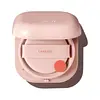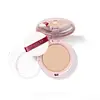What's inside
What's inside
 Key Ingredients
Key Ingredients

 Benefits
Benefits

 Concerns
Concerns

 Ingredients Side-by-side
Ingredients Side-by-side

Water
Skin ConditioningPhenyl Trimethicone
Skin ConditioningCI 77891
Cosmetic ColorantHomosalate
Skin ConditioningTitanium Dioxide
Cosmetic ColorantCaprylyl Methicone
Skin ConditioningGlycerin
HumectantLauryl PEG-10 Tris(Trimethylsiloxy)Silylethyl Dimethicone
EmulsifyingC12-15 Alkyl Benzoate
AntimicrobialTrimethylsiloxysilicate
EmollientPEG-10 Dimethicone
Skin ConditioningVp/Hexadecene Copolymer
Niacinamide
SmoothingIsododecane
EmollientDisteardimonium Hectorite
StabilisingPolyphenylsilsesquioxane
CI 77492
Cosmetic Colorant1,2-Hexanediol
Skin ConditioningAcrylates/Polytrimethylsiloxymethacrylate Copolymer
Skin ConditioningDimethicone
EmollientAluminum Hydroxide
EmollientSodium Chloride
MaskingSorbitan Sesquioleate
EmulsifyingGlyceryl Stearate Citrate
EmollientCI 77163
Cosmetic ColorantDisodium Stearoyl Glutamate
CleansingParfum
MaskingDimethicone/Polyglycerin-3 Crosspolymer
CleansingCI 77491
Cosmetic ColorantAlumina
AbrasiveCaprylyl Glycol
EmollientPolyhydroxystearic Acid
EmulsifyingStearic Acid
CleansingEthylhexyl Hydroxystearate
EmollientCI 77499
Cosmetic ColorantPanthenol
Skin ConditioningGlyceryl Caprylate
EmollientEthylhexylglycerin
Skin ConditioningTriethoxycaprylylsilane
Ethylhexyl Palmitate
EmollientLecithin
EmollientIsostearic Acid
CleansingIsopropyl Palmitate
EmollientDisodium EDTA
Stearoyl Glutamic Acid
CleansingSimethicone
EmollientPolyglyceryl-3 Polyricinoleate
EmulsifyingAscorbic Acid
AntioxidantHydrolyzed Hyaluronic Acid
HumectantCitronellol
PerfumingGeraniol
PerfumingLimonene
PerfumingDipropylene Glycol
HumectantButylene Glycol
HumectantNelumbo Nucifera Flower Extract
Skin ConditioningHydroxycitronellal
PerfumingSodium Citrate
BufferingTocopherol
AntioxidantSodium Benzoate
MaskingLactic Acid
BufferingPotassium Sorbate
PreservativeDiamond Powder
AbrasiveXanthan Gum
EmulsifyingWater, Phenyl Trimethicone, CI 77891, Homosalate, Titanium Dioxide, Caprylyl Methicone, Glycerin, Lauryl PEG-10 Tris(Trimethylsiloxy)Silylethyl Dimethicone, C12-15 Alkyl Benzoate, Trimethylsiloxysilicate, PEG-10 Dimethicone, Vp/Hexadecene Copolymer, Niacinamide, Isododecane, Disteardimonium Hectorite, Polyphenylsilsesquioxane, CI 77492, 1,2-Hexanediol, Acrylates/Polytrimethylsiloxymethacrylate Copolymer, Dimethicone, Aluminum Hydroxide, Sodium Chloride, Sorbitan Sesquioleate, Glyceryl Stearate Citrate, CI 77163, Disodium Stearoyl Glutamate, Parfum, Dimethicone/Polyglycerin-3 Crosspolymer, CI 77491, Alumina, Caprylyl Glycol, Polyhydroxystearic Acid, Stearic Acid, Ethylhexyl Hydroxystearate, CI 77499, Panthenol, Glyceryl Caprylate, Ethylhexylglycerin, Triethoxycaprylylsilane, Ethylhexyl Palmitate, Lecithin, Isostearic Acid, Isopropyl Palmitate, Disodium EDTA, Stearoyl Glutamic Acid, Simethicone, Polyglyceryl-3 Polyricinoleate, Ascorbic Acid, Hydrolyzed Hyaluronic Acid, Citronellol, Geraniol, Limonene, Dipropylene Glycol, Butylene Glycol, Nelumbo Nucifera Flower Extract, Hydroxycitronellal, Sodium Citrate, Tocopherol, Sodium Benzoate, Lactic Acid, Potassium Sorbate, Diamond Powder, Xanthan Gum
Mica
Cosmetic ColorantSilica
AbrasiveDimethicone
EmollientBoron Nitride
AbsorbentVinyl Dimethicone/Methicone Silsesquioxane Crosspolymer
Nylon-12
Phenyl Trimethicone
Skin ConditioningCaprylyl Glycol
EmollientTriethoxycaprylylsilane
Dimethicone/Vinyl Dimethicone Crosspolymer
Skin Conditioning1,2-Hexanediol
Skin ConditioningEthylhexylglycerin
Skin ConditioningAllantoin
Skin ConditioningWater
Skin ConditioningJojoba Esters
EmollientTocopheryl Acetate
AntioxidantButylene Glycol
HumectantHibiscus Sabdariffa Flower Extract
Skin ConditioningAloe Barbadensis Leaf Extract
EmollientCarthamus Tinctorius Flower Extract
Skin ConditioningChrysanthellum Indicum Extract
Skin ConditioningLonicera Japonica Flower Extract
Skin ConditioningNelumbo Nucifera Flower Extract
Skin ConditioningPhenoxyethanol
PreservativeSodium Hyaluronate
HumectantTitanium Dioxide
Cosmetic ColorantCI 77492
Cosmetic ColorantCI 77491
Cosmetic ColorantCI 77499
Cosmetic ColorantMica, Silica, Dimethicone, Boron Nitride, Vinyl Dimethicone/Methicone Silsesquioxane Crosspolymer, Nylon-12, Phenyl Trimethicone, Caprylyl Glycol, Triethoxycaprylylsilane, Dimethicone/Vinyl Dimethicone Crosspolymer, 1,2-Hexanediol, Ethylhexylglycerin, Allantoin, Water, Jojoba Esters, Tocopheryl Acetate, Butylene Glycol, Hibiscus Sabdariffa Flower Extract, Aloe Barbadensis Leaf Extract, Carthamus Tinctorius Flower Extract, Chrysanthellum Indicum Extract, Lonicera Japonica Flower Extract, Nelumbo Nucifera Flower Extract, Phenoxyethanol, Sodium Hyaluronate, Titanium Dioxide, CI 77492, CI 77491, CI 77499
Ingredients Explained
These ingredients are found in both products.
Ingredients higher up in an ingredient list are typically present in a larger amount.
1,2-Hexanediol is a synthetic liquid and another multi-functional powerhouse.
It is a:
- Humectant, drawing moisture into the skin
- Emollient, helping to soften skin
- Solvent, dispersing and stabilizing formulas
- Preservative booster, enhancing the antimicrobial activity of other preservatives
Butylene Glycol (or BG) is used within cosmetic products for a few different reasons:
Overall, Butylene Glycol is a safe and well-rounded ingredient that works well with other ingredients.
Though this ingredient works well with most skin types, some people with sensitive skin may experience a reaction such as allergic rashes, closed comedones, or itchiness.
Learn more about Butylene GlycolCaprylyl Glycol is a humectant and emollient, meaning it attracts and preserves moisture.
It is a common ingredient in many products, especially those designed to hydrate skin. The primary benefits are retaining moisture, skin softening, and promoting a healthy skin barrier.
Though Caprylyl Glycol is an alcohol derived from fatty acids, it is not the kind that can dry out skin.
This ingredient is also used as a preservative to extend the life of products. It has slight antimicrobial properties.
Learn more about Caprylyl GlycolCi 77491 is also hydrated iron III oxide. It's sole purpose is to give a red/pink hue to products.
Iron III oxides are classified as inorganic chemicals for coloring.
Synthetically created Ci 77491 is considered safer than those naturally found. This is because the synthetically created version may contain less impurities. Iron oxides are generally non-toxic and non-allergenic.
Learn more about CI 77491Ci 77492 is also hydrated iron III oxide. It's sole purpose is to give a yellow hue to products.
Iron III oxides are classified as inorganic chemicals for coloring.
Synthetically created Ci 77492 is considered safer than those naturally found. This is because the synthetically created version may contain less impurities. Iron oxides are generally non-toxic and non-allergenic.
Learn more about CI 77492Ci 77499 is also hydrated iron III oxide. It is created from mixing red and black iron oxides. This helps give shades of darkness to a product.
Iron III oxides are classified as inorganic chemicals for coloring.
Dimethicone is a type of synthetic silicone created from natural materials such as quartz.
What it does:
Dimethicone comes in different viscosities:
Depending on the viscosity, dimethicone has different properties.
Ingredients lists don't always show which type is used, so we recommend reaching out to the brand if you have questions about the viscosity.
This ingredient is unlikely to cause irritation because it does not get absorbed into skin. However, people with silicone allergies should be careful about using this ingredient.
Note: Dimethicone may contribute to pilling. This is because it is not oil or water soluble, so pilling may occur when layered with products. When mixed with heavy oils in a formula, the outcome is also quite greasy.
Learn more about DimethiconeEthylhexylglycerin (we can't pronounce this either) is commonly used as a preservative and skin softener. It is derived from glyceryl.
You might see Ethylhexylglycerin often paired with other preservatives such as phenoxyethanol. Ethylhexylglycerin has been found to increase the effectiveness of these other preservatives.
Nelumbium Speciosum Flower Extract comes from the Lotus Flower. It is rich in antioxidants.
The antioxidant properties in lotus flower come from compounds such as flavonoids.
In traditional Asian medicine, Lotus flower seeds were used to help treat inflammation.
Learn more about Nelumbo Nucifera Flower ExtractPhenyl Trimethicone is a silicon-based polymer. It is derived from silica.
Phenyl Trimethicone is used as an emollient and prevents products from foaming.
As an emollient, it helps trap moisture in the skin. It is considered an occlusive.
Learn more about Phenyl TrimethiconeTitanium dioxide is a mineral UV filter widely used in sunscreens and cosmetics.
It is one of only two UV filters officially classified as “mineral” by regulatory agencies, the other being zinc oxide.
Titanium dioxide provides broad-spectrum protection mostly in the UVB and UVAII range, with some protection in the UVAI range.
While its UVA protection isn’t as strong as zinc oxide’s, the difference is minor.
A common myth is that mineral UV filters reflect UV light. However, modern research shows titanium dioxide absorbs UV radiation like chemical filters (~95% absorption & 5% reflection).
Thanks to its non-irritating nature, titanium dioxide is suitable for sensitive, acne-prone, or redness-prone skin. It is unlikely to cause "eye sting" like other sunscreen ingredients.
A major drawback of this ingredient is its white cast and thick texture. This is why mineral sunscreens often leave a white cast and are less cosmetically elegant than chemical/hybrid sunscreens.
To improve white cast and spreadability, micronized or nano-sized titanium dioxide is often used.
There are ongoing concerns surrounding nano-titanium oxide's impact on marine ecosystems.
There is no conclusive evidence that any form of titanium oxide (or any other sunscreen ingredients) will cause harm to marine ecosystems or coral reefs. The science is still developing but many consumers are keeping a close eye on this issue.
Please note, many destinations have reef-safety sunscreen rules. For instance, the U.S. Virgin Islands advises all visitors to use non-nano mineral sunscreens.
Nano mineral sunscreens once raised safety concerns about absorption into skin.
Extensive research has shown that they do not penetrate healthy or damaged skin; they remain safely on the surface and the top layer of dead skin (stratum corneum).
You'll likely find titanium dioxide bundled with alumina, silica, or dimethicone. These ingredients help make titanium dioxide highly photostable; this prevents it from interacting with other formula components under UV light.
Learn more about Titanium DioxideTriethoxycaprylylsilane is a silicone used to bind and stabilize ingredients.
As an emulsifier, it helps prevent ingredients from separating. This can help elongate the shelf life of products.
Triethoxycaprylylsilane is often used to coat mineral sunscreens ingredients to help give a better feel. It also helps reduce oxidative stress in sunscreens.
Learn more about TriethoxycaprylylsilaneWater. It's the most common cosmetic ingredient of all. You'll usually see it at the top of ingredient lists, meaning that it makes up the largest part of the product.
So why is it so popular? Water most often acts as a solvent - this means that it helps dissolve other ingredients into the formulation.
You'll also recognize water as that liquid we all need to stay alive. If you see this, drink a glass of water. Stay hydrated!
Learn more about Water